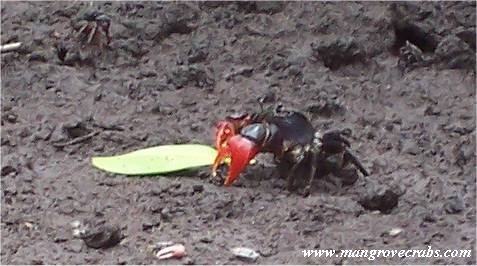|
A field guide to Kenyan
mangroves
|
Neosarmatium smithi H. Milne Edwards, 1853
Family: Sesarmidae
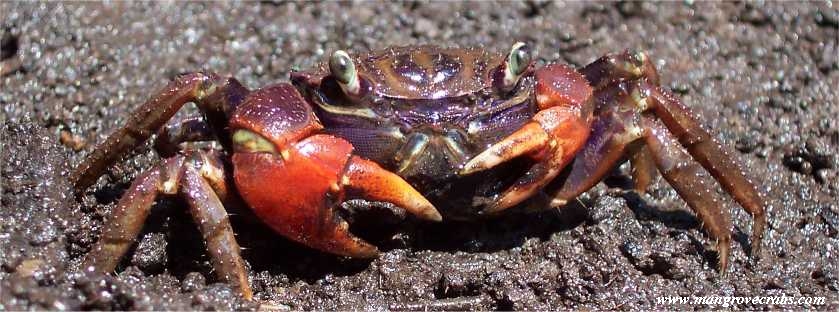
Zone: This large mangrove crab burrows from the seaward side of A. marina landward zone to the creek. Prefers muddy substrate. Generally found burrowing around Rhizophora mucronata roots - common in this zone.
Habitat: Burrowing to about 1 meter depth (Gillikin, 2000).
Food: Readily consumes leaf litter (Fratini et al., 2000; Gillikin, 2000) and probably feed on sediment and other crustaceans (Gillikin et al., 2001).
| Ecological notes: This species is very shy in its habits and has been classified as nocturnal (Pinto, 1984 cited in Davie, 1994), however recent studies report they are diurnal (Fratini et al., 2000; Gillikin, 2000) . They are medium sized crabs (maximum carapace width about 4.5 cm) of which little is known. Their burrows have not been described other than that they are complex structures that protrude above ground as a hollow cylinder (Pinto, 1984 cited in Davie, 1994). Macnae (1968) mentions the burrows of N. smithi may be 'turreted' and Hartnoll (1975) writes that they prefer the muddier regions of the swamp. Leaf-litter removal studies in areas where this species is present in Gazi Bay show that they are important litter consumers (Slim et al., 1997). They can withstand high salinities for short periods of time, but salinities of 65 prove fatal after about one week (Gillikin et al., 2004). Burrow associates include: Sesarma guttatum, mosquito larvae and mosquitoes, amphipods and the semi-terrestrial shrimp Merguia oligodon (Gillikin, 2000; Gillikin et al., 2001). |
|
Distinguishing characteristics: Size (carapace width about 4cm), two prominent spines on top of claw, claws all red.
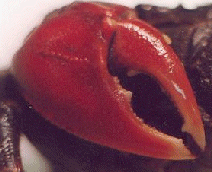
Claw detail (notice characteristic spines on top of claw)
Geographical range: N. smithi is widely distributed throughout the Indo-Pacific, but has been wrongly identified in the south-western Pacific where it is replaced by its sisters species N. trispinosum Davie, 1994 (Davie, 1994; Davie, pers. comm.). It occurs from South Africa (Emmerson, 1994) to Somalia (Vannini and Valmori, 1981) and in India and South-East Asia as far north as Japan (Davie, 1994).
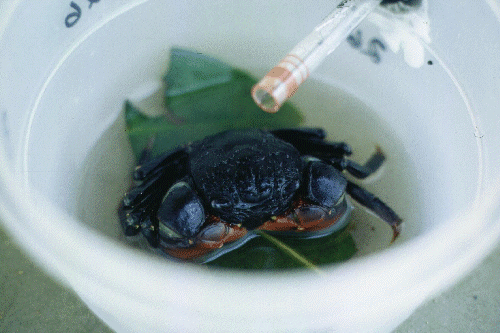
N. smithi during laboratory experiments
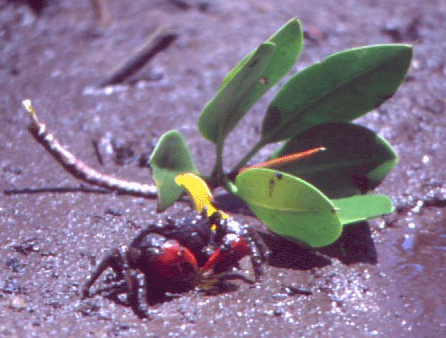
References:
Cannicci, S., F. Dahdouh-Guebas and L. Montemagno, 1993. "Field Keys for Kenyan Mangrove Crabs." Museo Zoologico "La Specola", Dipartimento di Biologia Animale e Genetica dell'Università Degli Studi di Firenze, Via Romana 17, I-50125 Firenze, Italia.
Davie, P.J.F., 1994. Revision of Neosarmatium Serène and Soh (Crustacea: Brachyura: Sesarminae) with descriptions of two new species. Memoirs of the Queensland Museum 35:35-74.
Emmerson, W.D., 1994. A note on three uncommon southern African grapsids, Helice leachii Hess, 1865, Sesarma (Sesarma) longipes Krauss, 1843 and Sesarma (Sesarma) smithi H. Milne Edwards, 1853. Crustaceana 67(3): 316-323.
Fratini, S., S. Cannicci and M. Vannini, 2000. Competition and interaction between Neosarmatium smithi (Crustacea: Grapsidae) and Terebralia palustris (Mollusca: Gastropoda) in a Kenyan mangrove. Marine Biology 137(2): 309-316.
Gillikin, D.P., 2000. Factors controlling the distribution of Kenyan brachyuran mangrove crabs: Salinity tolerance and ecophysiology of two Kenyan Neosarmatium species. M.Sc. Thesis, Free University of Brussels, Brussels, Belgium.
Gillikin, D.P., S. De Grave and J.F. Tack, 2001. The occurrence of the semi-terrestrial shrimp Merguia oligodon (De Man, 1888) in Neosarmatium smithi H. Milne Edwards, 1853 burrows in Kenyan mangroves. Crustaceana 74(5): 505-508. (REPRINT)
Gillikin, D.P., B. De Wachter and J.F. Tack, 2004. Physiological responses of two ecologically important Kenyan mangrove crabs exposed to altered salinity regimes. Journal of Experimental Marine Biology and Ecology 301(1):93-109. (http://authors.elsevier.com/sd/article/S002209810300474X) (REPRINT)
Hartnoll, R.G., 1975. "The Grapsidae and Ocypodidae (Decapoda: Brachyura) of Tanzania." J. Zool. Lond. 177:305-328.
Vannini, M. and P. Valmori, 1981. Researchers on the coast of Somalia. The shore and the dune of Sar Uanle. 30. Grapsidae (Decapoda Brachyura). Monitore Zoologico Italiano 6: 57-101.
